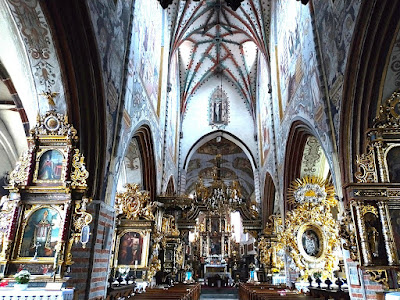Basilicas in Poland—Gdansk
I blogged about the following basilica on February 28, 2020.
- The Cathedral Basilica of the Holy Trinity, Blessed Virgin Mary, and St. Bernard in Gdansk.
- The Co-Cathedral of the Assumption of the Blessed Virgin Mary in Gdansk.
Basilica of St. Nicholas (Shrine of Our Lady of Victory), Gdansk, Pomerania
Declared a minor basilica by Pope Pius XI in 1928.
The brick Gothic building was built as the church for a Dominican monastery in the 14th and 15th Centuries. It replaced a Romanesque parish church that was built in 1185. The church was plundered and destroyed many times during the Reformation and several monks were killed. It was given by local authorities to Protestants briefly before being returned to Catholics in 1567. The Russians burned down the monetary buildings in 1813 and the Dominicans left a few years later. They returned in 1945. The church had to be closed in 2018 because of its poor physical condition and renovations are underway.
All pictures are from Wikipedia.
Cathedral Basilica of St. John the Baptist and St. John the Evangelist, Torun, Kuyavia-Pomerania
Declared a minor basilica by Pope Pius XI in 1935.
The basilica is the cathedral for the Diocese of Torun. The Gothic brick church essentially dates to the 15th Century (portions of the church date to the 14th Century). The church has memorabilia of Nicolaus Copernicus, who was born in Torun. Protestants took control of the church in 1530, and Protestants and Catholics shared the church between 1583 and 1596 when the king gave the church to the Jesuits. The church has several paintings from the 14th Century.
All pictures are from Wikipedia.
Cathedral Basilica of the Assumption of the Blessed Virgin Mary, Pelplin, Pomerania
Declared a minor basilica by Pope Paul VI in 1965.
The basilica is the cathedral for the Diocese of Pelplin. The brick Gothic church was originally built as the church for a Cistercian monastery in the 14th Century. The church was renovated in a Baroque style in the 17th and 18th Centuries, before being renovated in a Gothic style in the late 19th Century. The Cistercians left in 1823, and it became a cathedral in 1824. The former monastery buildings now house a seminary.
All pictures are from Wikipedia.
Basilica of St. Thomas the Apostle, Nowe Miasto Lubawskie, Warmia-Masuria
Declared a minor basilica by Pope Paul VI in 1971.
The Gothic church was built in the 14th and 15th Centuries.
All pictures are from Wikipedia.
Co-Cathedral Basilica of the Most Holy Trinity, Chelmza, Kuyavia-Pomerania
Declared a minor basilica by Pope John Paul II in 1982.
The basilica is the co-cathedral for the Diocese of Torun and was once the cathedral for a now-suppressed diocese. The church got off to a slow start—it was twice destroyed by the Prussians while under construction in the 13th Century. It has survived fires and ill-advised renovations. Reconstruction from 1968 to 1971 restored it to it former Gothic appearance.
All pictures are from Wikipedia.
Basilica of St. Brigid, Gdansk, Pomerania
Declared a minor basilica by Pope John Paul II in 1991.
A chapel was built here in 1350 and became a pilgrimage destination after reports of an apparition of the Virgin Mary. In 1374, a procession carrying the mortal remains of St. Bridget from Rome to Vadstena in Sweden, stopped here. Some of St. Bridget’s relics remained here and in 1392, sisters from St. Bridget’s Order of the Most Holy Savior arrived from Vadstena and established a monastery. A new church was built which took until 1512 to complete. As often seems the case in Europe, problems soon developed, first with a fire and conflicts with Lutherans in the late 16th Century. This was followed by almost 200 years of peace and tranquility until the Prussians took over the property in the late 1700s followed by devastation caused by a Russian invasion in 1807. The church endured more bad treatment by the Germans in the Second World War. The church was rebuilt in the 1970s and in the 1980s became a center for Poland’s Solidarity movement.
All pictures are from Wikipedia.
Basilica of the Beheading of St. John the Baptist, Chojnice, Pomerania
Declared a minor basilica by Pope John Paul II in 1993.
The Gothic church was built between 1340 and 1360 to replace a wooden building. The church was taken over by Protestants in 1555 and the parish priest was killed in a riot in front of the church. Catholics reclaimed the church in 1616. The church has survived three fires.
All pictures are from Wikipedia.
Basilica of St. Nicholas and Shrine of Our Lady of Grace, Grudziadz, Kuyavia-Pomerania
Declared a minor basilica by Pope Benedict XVI in 2010.
The brick Gothic church was built in the early 14th Century. It was a Protestant church for periods in the 16th and 17th Centuries. The church was heavily damaged in 1945 but has been restored. The church has a 17th Century painting of the Madonna and Child Jesus.
All pictures are from Wikipedia.
Basilica of the Assumption of the Blessed Virgin Mary, Koronowo, Kuyavia-Pomerania
Declared a minor basilica by Pope Benedict XVI in 2010.
The brick Gothic church was built in the 13th and early 14th Centuries as a church for a Cistercian monastery. It burned in the late 14th Century, was rebuilt, and destroyed by the Swedes in 1656. It was once again rebuilt with a mixture of Gothic, Baroque, and Rococo styles. The monastery was closed in 1819.
All pictures are from Wikipedia.
Basilica of Our Lady Queen of Poland, Gdynia, Pomerania
Declared a minor basilica by Pope Francis in 2018.
The Baroque and Renaissance church was completed in 1924.
Both pictures are from Wikipedia.













































































